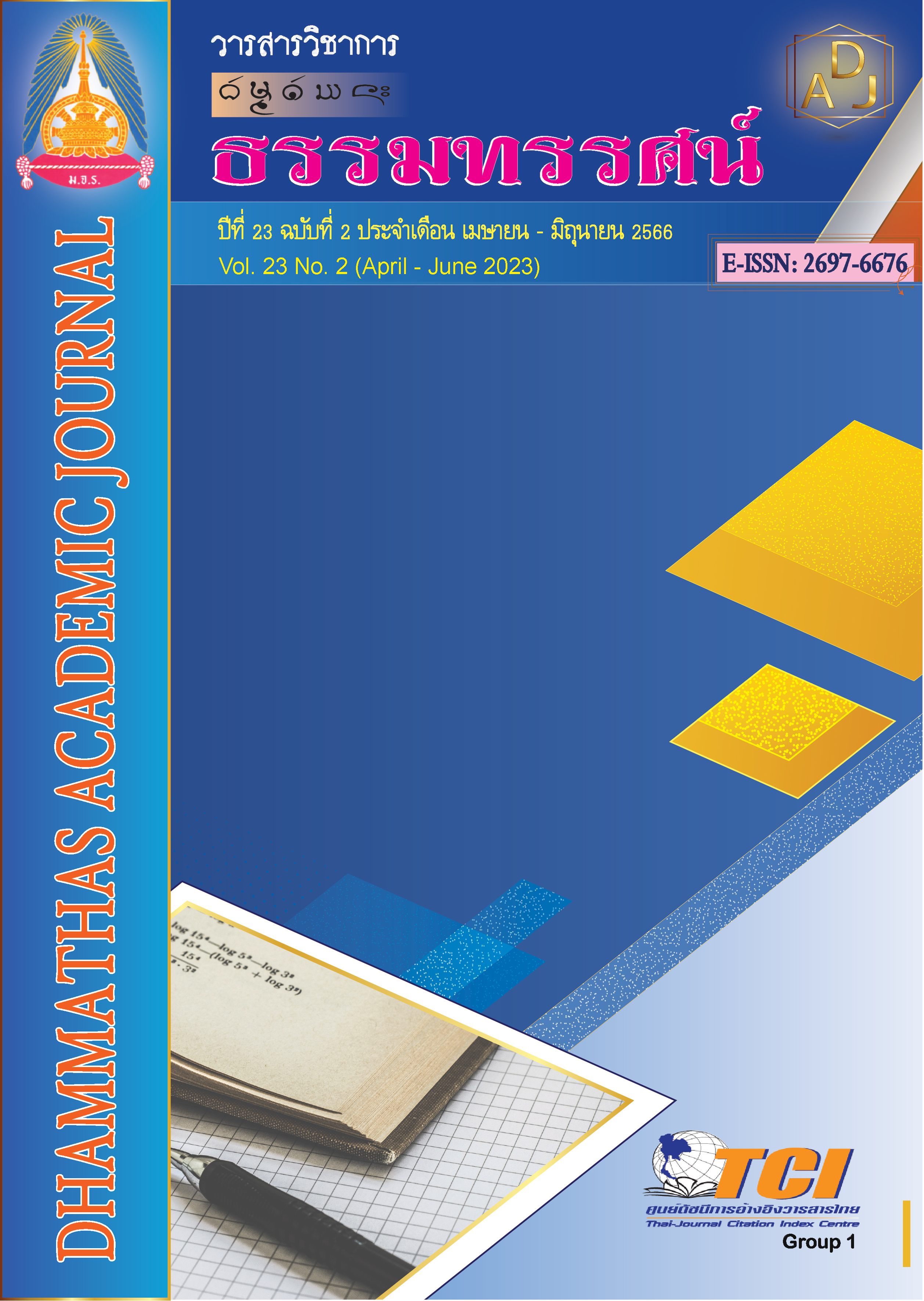Using Japanese Blackboard Writing to Enhance Students’ Computational Thinking in Classroom by Using Lesson Study and Open Approach
Main Article Content
Abstract
This research objective was to study the pattern usage of Japanese blackboard writing to enhance students’ computational thinking in the classroom by using lesson study and open approach, is qualitative research the target groups were: twenty-three students from Grade 3 students and five persons in lesson study team in the first semester of the academic year 2021 from a small public primary school in Phitsanulok. The data were collected during ten weeks using lesson plans, teacher’s field notes, video records, pictures, and students’ worksheets. Analysis methods were content analysis and video with protocol analysis, and descriptive analysis was used to present the information.
The results showed that: the lesson study team created a lesson plan which focused on how to use Japanese blackboard writing to enhance students’ computational thinking as follows: 1) The left area: The teacher used for lesson revision or the posting pictures of an open-ended problem relating to the student’s daily life with conditions and rules. These pictures are a concrete representation. This area is to encourage students to be interested and take into account student’s problematic. 2) The middle area was used to post an open-ended situation, the order of activity, and the presentation of students’ ideas that had been anticipated before. Teachers consider the teaching aids as a semi-concrete representation, such as cards and conditional cases for expanding and linking students’ ideas in each group. This area is to motivate the whole class discussion and comparison with the use of teacher questions for encouraging the students’ thinking and 3) The right area was utilized for summarizing the solution process and students’ computational thinking involving to the lesson objectives through whole class discussion. This area is leading to abstract representation such as sequences, conditionals, and loops and then the cognitive tools of learners was created to use connect to the future lessons.
Article Details

This work is licensed under a Creative Commons Attribution-NonCommercial-NoDerivatives 4.0 International License.
เพื่อให้เป็นไปตามกฎหมายลิขสิทธิ์ ผู้นิพนธ์ทุกท่านต้องลงลายมือชื่อในแบบฟอร์มใบมอบลิขสิทธิ์บทความ ให้แก่วารสารฯ พร้อมกับบทความต้นฉบับที่ได้แก้ไขครั้งสุดท้าย นอกจากนี้ ผู้นิพนธ์ทุกท่านต้องยืนยันว่าบทความ ต้นฉบับที่ส่งมาตีพิมพ์นั้น ได้ส่งมาตีพิมพ์เฉพาะในวารสาร วิชาการธรรม ทรรศน์ เพียงแห่งเดียวเท่านั้น หากมีการใช้ ภาพหรือตารางของผู้นิพนธ์อื่นที่ปรากฏในสิ่งตีพิมพ์อื่นมาแล้ว ผู้นิพนธ์ต้องขออนุญาตเจ้าของลิขสิทธิ์ก่อน พร้อมทั้ง แสดงหนังสือที่ได้รับการยินยอมต่อบรรณาธิการ ก่อนที่บทความจะได้รับการตีพิมพ์References
ไกรลาส มาตรมูล และคณะ. (2565). การกำหนดเนื้อหาสาระการเรียนรู้ของบทเรียนจากแนวคิดเชิงคำนวณของนักเรียนผ่านการศึกษาชั้นเรียน: ขั้นสร้างแผนจัดการเรียนรู้ร่วมกัน. วารสารวิจัย มข. (ฉบับบัณฑิตศึกษา) สาขามนุษยศาสตร์และสังคมศาสตร์, 10(1), 164-179.
ไกรลาส มาตรมูล, พิชิตชัย ปิมแปง เเละเทพธิทัต เขียวคำ. (2566). การใช้การคิดเชิงคำนวณของนักเรียนในการเขียนโปรแกรมเพื่อบรรลุจุดประสงค์ของบทเรียนผ่านกิจกรรมแบบ Unplugged: เน้นขั้นการสอนและการสังเกตชั้นเรียนร่วมกันโดยใช้การศึกษาชั้นเรียนและวิธีการแบบเปิด. วารสารพัฒนาการเรียนการสอน มหาวิทยาลัยรังสิต, 17(2).
ชูศักดิ์ อุดอิ่นแก้ว และเจนสมุทร แสงพันธ์. (2556). การใช้กระดานดำแบบญี่ปุ่นเพื่อส่งเสริมการอภิปรายและเปรียบเทียบร่วมกัน ในชั้นเรียนคณิตศาสตร์ที่สอนด้วยวิธีการแบบเปิด. วารสารวิธีวิทยาการวิจัย, 26(1), 91-108.
เริงนภา อำทะวงษ์, เกียรติ แสงอรุณ และสัมพันธ์ ถิ่นเวียงทอง. (2565). การวิเคราะห์องค์ประกอบการออกแบบแผนการจัดการเรียนรู้ที่เน้นแนวคิดของนักเรียนในการปฏิบัติการสอนที่ใช้การศึกษาชั้นเรียนและวิธีการแบบเปิด เพื่อเรียนรู้แนวคิดของนักเรียน. วารสารวิชาการธรรมทรรศน์, 22(2), 97-112.
สถาบันส่งเสริมการสอนวิทยาศาสตร์และเทคโนโลยี. (2561). หนังสือเรียนรายวิชาเทคโนโลยี (วิทยาการคำนวณ) ตามหลักสูตรแกนกลางการศึกษาขั้นฐาน พ.ศ. 2551 (ฉบับปรับปรุง พ.ศ. 2560) ระดับชั้นประถมศึกษาปีที่ 3. กรุงเทพฯ: กระทรวงศึกษาธิการ.
สุภารัตน์ คาระวะ และสัมพันธ์ ถิ่นเวียงทอง. (2564). กระบวนการมีปัญหาของตนเองของนักเรียนในชั้นเรียนที่ใช้การศึกษาชั้นเรียนและวิธีการแบบเปิด. วารสารวิชาการธรรมทรรศน์, 21(4), 81-92.
Baldry, F., et al. (2023). The use of carefully planned board work to support the productive discussion of multiple student responses in a Japanese problem-solving lesson. Journal of Mathematics Teacher Education, 26, 129-153.
Brennan, K., and Resnick, M. (2012). New Frameworks for Studying and Assessing the Development of Computational Thinking. In Proceedings of the 2012 Annual Meeting of the American Educational Research Association, April 2012, 25 (pp. 1-25). Canada: Vancouver, BC.
Inprasitha, M. (2022). Lesson study and open approach development in Thailand: a longitudinal study. International Journal for Lesson and Learning Studies, 11(5), 1-15.
Kuehnert, E. R., et al. (2018). Bansho: visually sequencing mathematical ideas. Teaching Children Mathematics, 24(6), 362-369.
Ninomiya, H. (2010). Board Writing and Teaching Hot to Write Note. In M. Isoda, and T. Nakamura. (Eds.), Special Issue (EARCOME 5) Mathematics Education Theories for Lesson Study: Problem Solving Approach and the Curriculum through Extension and Integration (p. 1). Tokyo: Bunshoudo Insatusho.
Threekunprapa, A. and Yasri, P. (2020). Unplugged Coding Using Flowblocks for Promoting Computational Thinking and Programming among Secondary School Students. International Journal of Instruction, 13(3), 207-222.
Yoshida, M. (2005). Using lesson study to develop effective blackboard practice. In P. Wang-Iverson & M. Yoshida (Eds.), Building our understanding of lesson study (pp. 93-100). USA: Research for Better Schools, Inc.

